Looks super cool! Is this type of co-culture prepared from separate animals/stages or from one preparation?
23.10.2025 17:26 — 👍 0 🔁 0 💬 1 📌 0
This #microscopymonday is a cleaning day. Watch how a #microglia cell mops up and phagozytoses debris and junk in a very messy neuronal co-culture. BTW, it was a proper cleaning job → the neurons made it and formed nice networks
Phase contrast imaging started at DIV1. One frame per 20 min.
12.10.2025 16:32 — 👍 24 🔁 8 💬 2 📌 0
🧠🦈Excited to present our latest work🧠🦈Interested in brain evolution? And shark embryos? Then read on… Our work sheds light on the deep origins of our brain’s most complex regions.
02.09.2025 17:45 — 👍 94 🔁 29 💬 6 📌 3
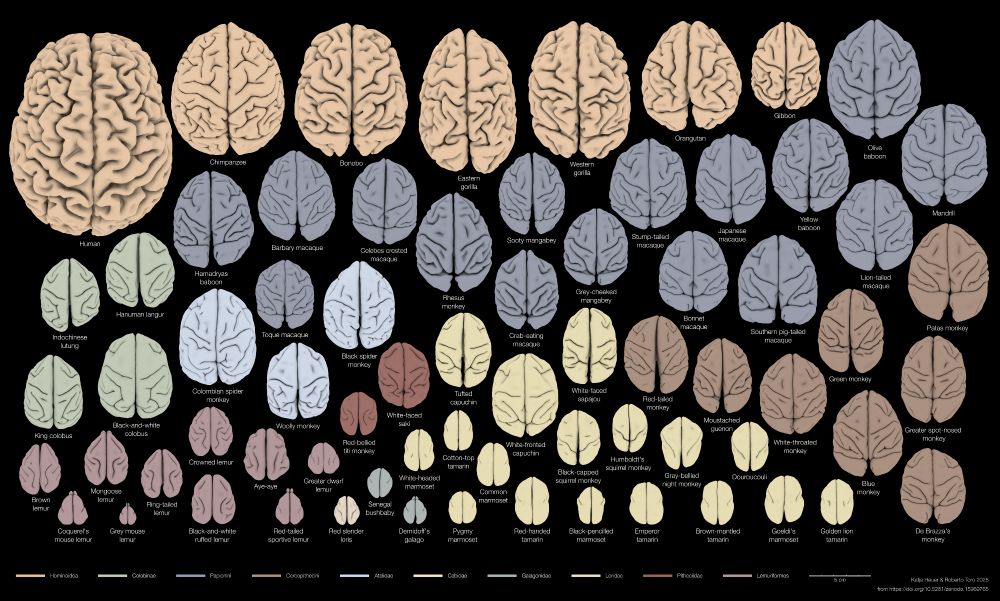
Brain Surfaces of 70 primate species
1
To predict the behaviour of a primate, would you rather base your guess on a closely related species or one with a similar brain shape? We looked at brains & behaviours of 70 species, you’ll be surprised!
🧵Thread on our new preprint with @r3rt0.bsky.social , doi.org/10.1101/2025...
27.07.2025 17:26 — 👍 497 🔁 225 💬 15 📌 26
Love this!
Tooting my own horn here, but if you’re interested in some of the practical considerations mentioned at the end of the article, you can check out this perspective from earlier in my postdoc: www.cell.com/neuron/fullt...
18.07.2025 17:01 — 👍 31 🔁 7 💬 0 📌 0

Graphical abstract for "Vocal communication is seasonal in social groups of wild, free-living house mice."
The abstract has, from top to bottom, a title, four middle image panels, and two bottom text panels.
Image title: "Vocal communication in social groups of wild-free living house mice"
Middle image panels from left to right: (1) An aerial snap shot of the region where the study site is located, an agricultural landscape in rural Switzerland. (2) An image of the study site, a small barn in the forest inhabited by mice. (3) An image of a radio frequency identification (RFID) box used to track mouse social interactions. A mouse is entering the box from the left while another sits outside. (4) A spectrogram showing example vocalizations - one low frequency squeak and one ultrasonic call - recorded from an RFID box.
Bottom panels:
Left: Data Collection
- 10 years of RFID-based tracking data (from 6,946 mice)
- 15 months of acoustic monitoring (totaling 6,594 hours)
- Machine learning for vocal detection and labeling (CNN)
Right: Key Findings
- Vocalization is seasonal (most in spring and summer)
- Vocalization is associated with the presence of pups
- Vocalization is correlated with social group dynamics
Very happy to share the latest from my postdoc!
10 yrs of mouse social networks + 1.25 yrs of acoustic data ➡️ insight into vocalization & sociality in a wild population of your favorite lab model 🐁
paper: bit.ly/4n93yyD
data: bit.ly/4lfFBEk
code: bit.ly/4kNnMwx
#bioacoustics #neuroskyence
1/8
18.06.2025 18:25 — 👍 135 🔁 47 💬 4 📌 8


It’s a quill? A sea pen? No—it’s a gill filament! 🪶🪸🐟
Under the microscope, this fish gill structure looks just like a sea pen.
Fascinating how nature keeps circling back to the same shapes.
Want to learn how gills develop?
👉 www.biorxiv.org/content/10.1...
#FluorescenceFriday #Zebrafish
20.06.2025 13:30 — 👍 28 🔁 7 💬 2 📌 2
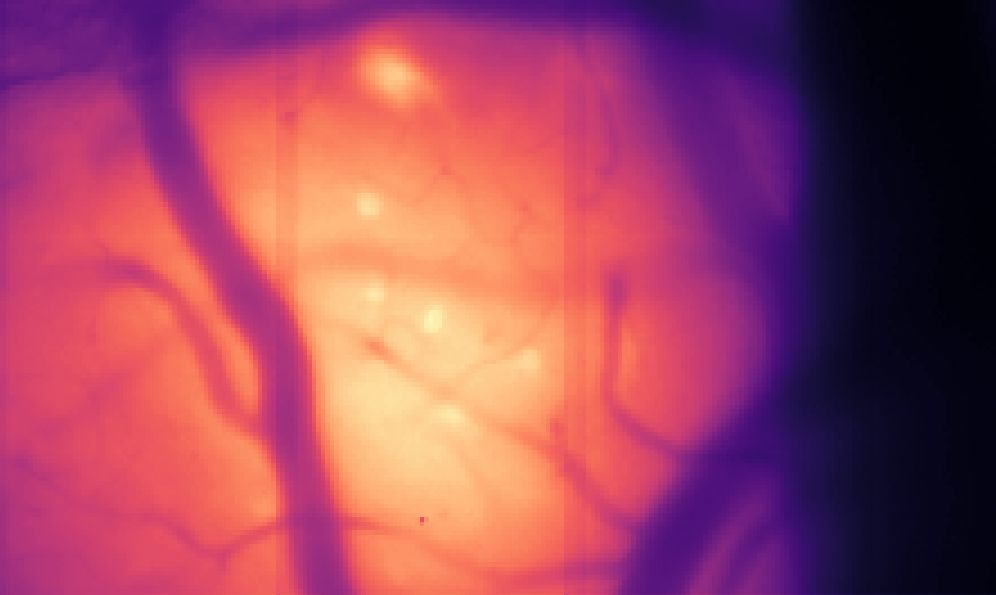
Brightly labelled pyramidal cells in the mouse retrosplenial cortex. Blood vessels are visible of various thicknesses in darker colours.
#neuroskyence folks: as my postdoc grant is running out soon, I am looking for new opportunities in systems neuroscience!
Keywords: patch clamp ephys, opto, mouse behavior, (in vivo) voltage imaging. Would love to return to the Basal Ganglia.
Sharing appreciated, and happy #FluorescenceFriday !
13.06.2025 13:33 — 👍 74 🔁 54 💬 6 📌 1
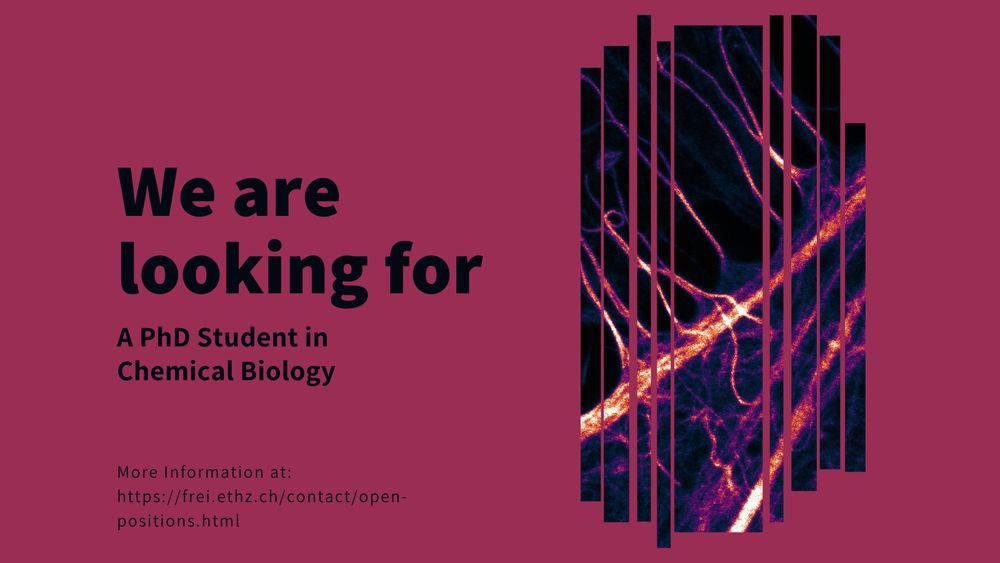
Advertisement for PhD position
My lab at @ethzurich.bsky.social is looking for a motivated PhD student. We develop chemical tools for advanced fluorescence microscopy 🔬 and work at the interface of synthetic chemistry ⚗️ and protein engineering 🦠. Sharing with skilled Master students appreciated. More info at tinyurl.com/2dbjk5ty
08.04.2025 08:06 — 👍 23 🔁 18 💬 1 📌 1
🚨iGluSnFR4 is finally out!🚨🧪
We present iGluSnFR4f and 4s, a novel pair of genetically-encoded glutamate indicators designed for high-fidelity imaging of synaptic activity in the living brain. ⬇️
www.biorxiv.org/content/10.1...
🎥 Below: iGluSnFR4s detecting minis in cultures w/ TTX
#Neuroscience
25.03.2025 12:10 — 👍 170 🔁 58 💬 7 📌 4
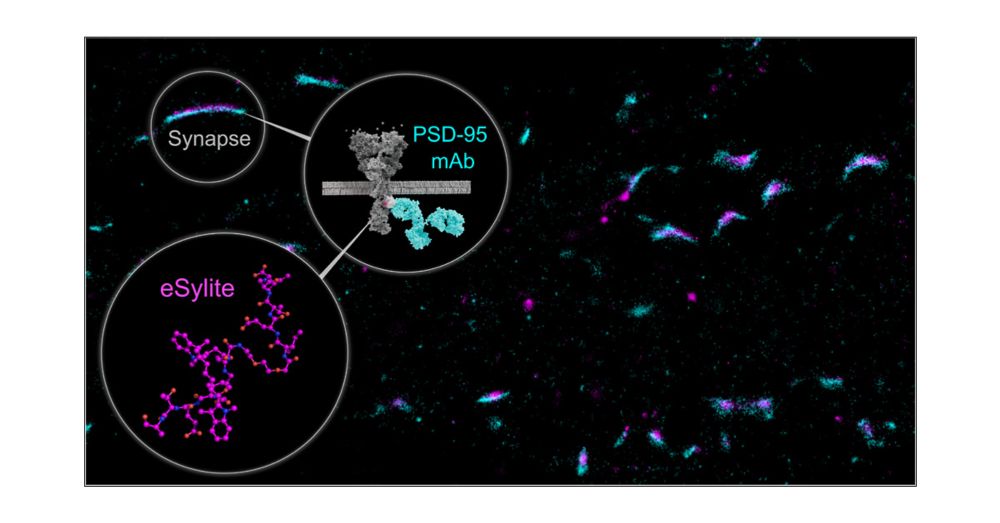
eSylites: Synthetic Probes for Visualization and Topographic Mapping of Single Excitatory Synapses
The spatiotemporal organization of the postsynaptic density (PSD) is a fundamental determinant of synaptic transmission, information processing, and storage in the brain. The major bottleneck that prevents the direct and precise representation of the nanometer-scaled organization of excitatory glutamatergic synapses is the size of antibodies, nanobodies, and the genetically encoded fluorescent tags. Here, we introduce small, high affinity synthetic probes for simplified, high contrast visualization of excitatory synapses without the limitations of larger biomolecules. In vitro binding quantification together with microscopy-based evaluation identified eSylites, a series of fluorescent bivalent peptides comprising a dye, linker, and sequence composition that show remarkable cellular target selectivity. Applied on primary neurons or brain slices at nanomolar concentrations, eSylites specifically report PSD-95, the key orchestrator of glutamate receptor nanodomains juxtaposed to the presynaptic glutamate release sites that mediate fast synaptic transmission. The eSylite design minimizes a spatial dye offset and thereby enables visualization of PSD-95 with improved localization precision and further time-resolved discrimination. In particular, we find that individual dendritic spines can contain separate nanodomains enriched for either PSD-95 or its closest homologues, PSD-93 or SAP102. Collectively, these data establish eSylites as a broadly applicable tool for simplified excitatory synapse visualization, as well as a high-end microscopy compatible probe for resolving the PSD organization with unprecedented resolution.
🚀 Excited to share our latest work in #JACS on eSylites!
—Synthetic, high-affinity #ChemicalBiology probes for #SuperResolution #Synapse visualization & precise mapping in neurons and brain slices—without the need for antibodies, tags, or transfection!
📢 Read more: pubs.acs.org/doi/10.1021/...
20.03.2025 17:21 — 👍 14 🔁 5 💬 0 📌 2

Crick BioImage Analysis Sympsoium Logo
Calling all...
🔬 Microscopists
💻 BioImage Analysts
👩🔬 Life Scientists
📅 Save the Date
The 5th edition of the Crick BioImage Analysis Symposium will take place on November 24/25th 2025.
More details to follow...
#CBIAS2025
17.03.2025 20:19 — 👍 56 🔁 35 💬 0 📌 3
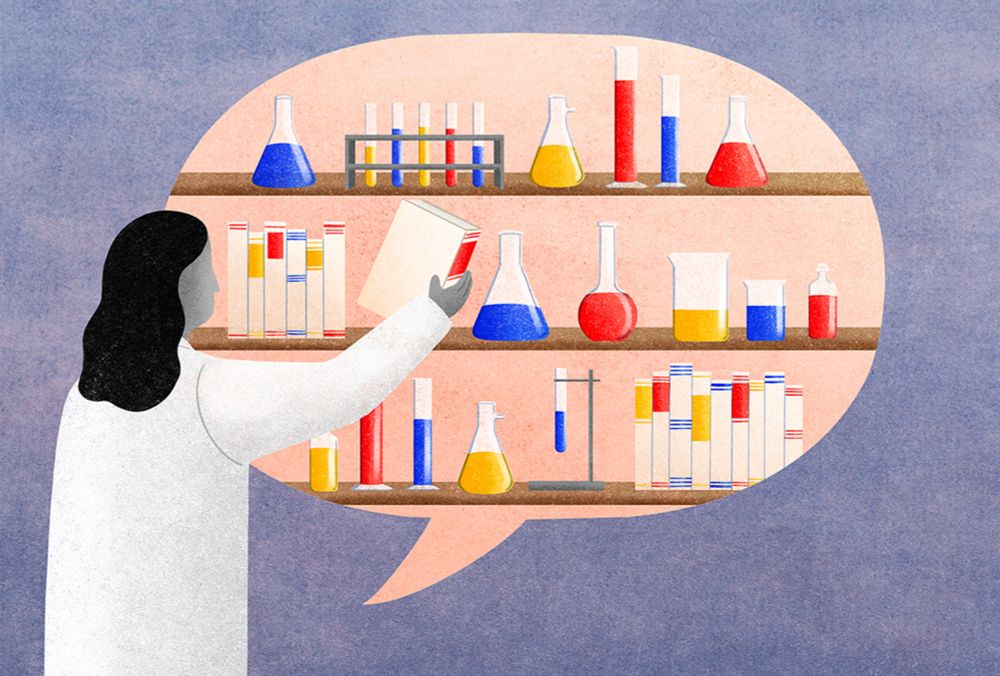
How to communicate the value of curiosity-driven research
The burden of proof is on us, as researchers, to explain why what we do is valuable to society.
We must learn to showcase the practical significance of basic research, demonstrating how seemingly arcane investigations yield transformative applications, writes @tonyzador.bsky.social www.thetransmitter.org/outreach/how...
04.03.2025 15:16 — 👍 53 🔁 33 💬 0 📌 2
Making intrabodies from antibodies just got easier! Learn how we made 𝟭𝟵 intrabodies to bind and light up peptides and histone modifications in live cells. And thanks to Academia, all sequences are freely available. (video credit: Yuko Sato @YukoSatoT2) (1/15)
www.biorxiv.org/content/10.1...
12.02.2025 06:28 — 👍 221 🔁 96 💬 12 📌 16
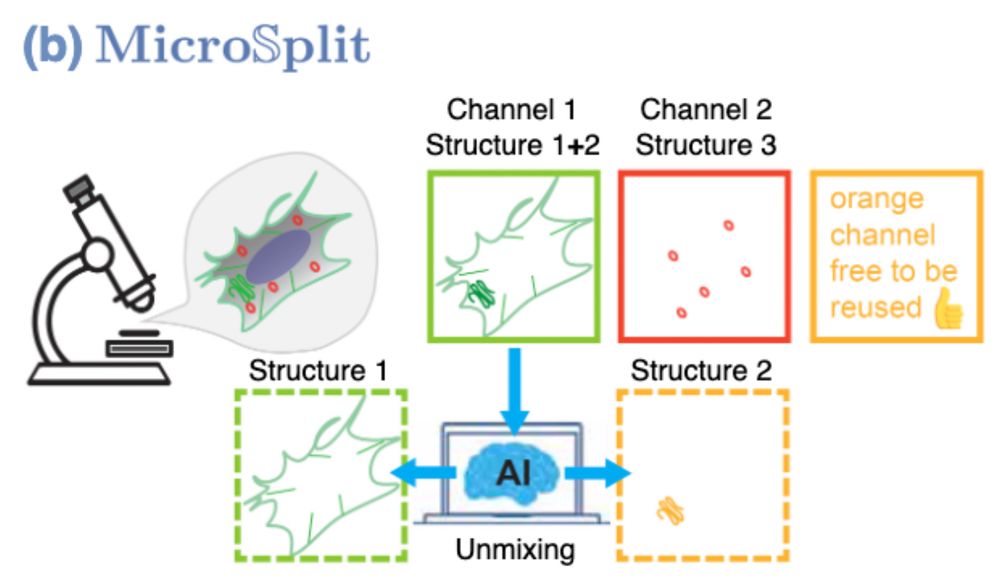
Schematic overview on how MicroSpit operates. It can split superimposed structures in fluorescent image channels by using a suitably trained AI.

Concrete example for how MicroSplit unmixes four superimposed structures.
Immagine you could image two cellular structures in the same fluorescent channel and still reliably get them separated afterwards…
What would you do with this?
Now… what would you do if that also worked with 4 structures at once? 👇 #MicroSplit #preview🧵
08.02.2025 07:49 — 👍 110 🔁 39 💬 6 📌 3

Home
This site contains the complete version of the Fiji Training Manual that is written and maintained by Cameron Nowell of the Monash Institue of Pharmaceutical Science.
This manual is provided under the...
Answering the call of @haesleinhuepf.bsky.social, Christian Tischer, Pete Bankhead, @kbias.bsky.social @bethcimini.bsky.social
My Fiji training notes are now FAIR. All online in an open format to download and use for teaching and training. All in Google Doc or PDF formats
bit.ly/4hkfEBF
05.02.2025 22:57 — 👍 65 🔁 28 💬 3 📌 2
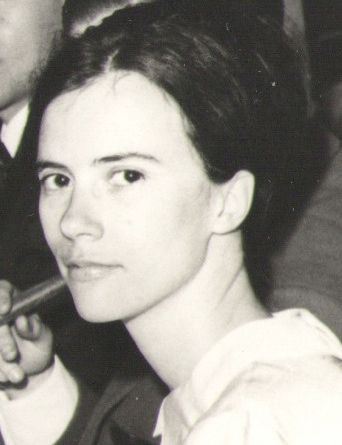
A portrait of Daisy Roulland-Dussoix from Wikipedia: https://en.wikipedia.org/wiki/Daisy_Roulland-Dussoix
Do you know Daisy Roulland-Dussoix? She is one of the discoverers of restriction enzymes, who’s findings paved the way for the development of recombinant DNA and cloning technologies. Accordingly, the finding was rewarded with a #NobelPrize. But the prize didn’t go to her.
🧵👇
01.02.2025 15:28 — 👍 262 🔁 125 💬 7 📌 23

A pyramidal neuron from the prefrontal cortex. #microscopymonday
Labelled with DiI, imaged with the FV3000 CLSM, & depicted using @kwolbachia.bsky.social new KTZ_bw_kawa LUT.
27.01.2025 05:38 — 👍 58 🔁 7 💬 2 📌 0
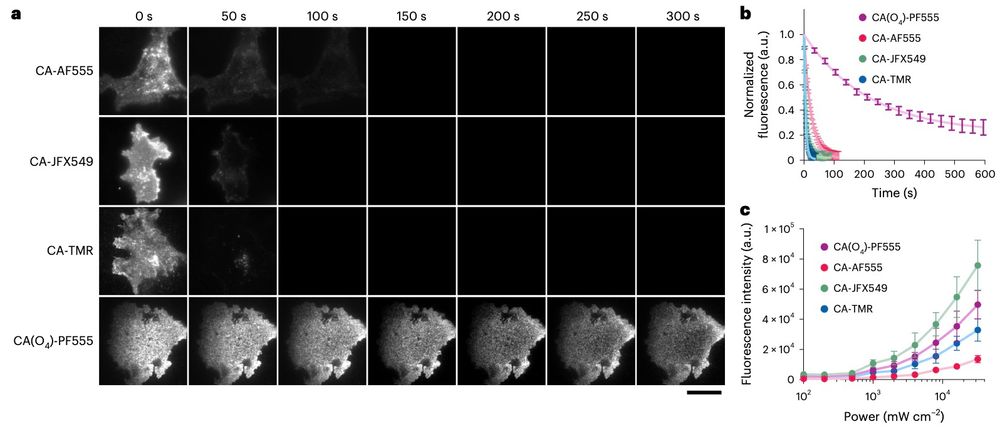
There are new stable red fluorescent proteins coming, but organic fluorophores are fighting back! Impressive photostability of Phoenix Fluor 555 for live-cell imaging with HaloTag, just out in @naturemethods.bsky.social:
doi.org/10.1038/s415...
16.01.2025 10:52 — 👍 70 🔁 20 💬 6 📌 0

Synthetic anti-RNA antibody derivatives for RNA visualization in mammalian cells
Abstract. Although antibody derivatives, such as Fabs and scFvs, have revolutionized the cellular imaging, quantification and tracking of proteins, analogo
What a fantastic way to start the year! The KoiralaLab (unfortunately not here yet) have just developed RNA derived antibodies to visualize RNA in live cells! This seems to be a promising alternative to the MCP-MS2 system whilst offering potential multiplexing capabilities.
#RNA, #RNASky, #imaging
01.01.2025 10:58 — 👍 77 🔁 18 💬 3 📌 3
There are now 24 step-by-step guides, explaining how to create these ⬇️ data visualizations with R/ggplot2 - I hope this is a useful resource. Find them all here: joachimgoedhart.github.io/DataViz-prot...
16.12.2024 09:25 — 👍 547 🔁 192 💬 17 📌 14

Excited to share our latest work! In it, we develop a new method for studying RNA localization via proximity labeling: OINC-seq! In contrast to other proximity-based methods, labels deposited on RNAs are read directly by sequencing without the need for biotinylation. biorxiv.org/cgi/content/...
13.11.2024 16:46 — 👍 134 🔁 45 💬 6 📌 11
Extended Timing: How neurons encode information on timescales that match learning | Max Planck Florida Institue for Neuroscience mpfi.org/extended-tim...
Dendritic, delayed, stochastic CaMKII activation in behavioural time scale plasticity | Nature www.nature.com/articles/s41...
#openaccess
14.10.2024 15:16 — 👍 0 🔁 1 💬 0 📌 0
MD, PhD | psychiatry | neuroscience | neuroeconomics | neuromodulation | assistant professor | residency program training director @MountSinaiPsych @SinaiBrain 🧠
Cell & Neurobiologist. Group Leader & Lecturer at the Institute of Biochemistry, Charité Berlin. Research interest in the actin cytoskeleton and membrane trafficking in astrocytes.
RNA biology, gene regulation, nervous system function and development
Researching neurodegeneration using flies. Based at Edinburgh University. UKDRI.
Also Music. Politics. Ceramics. Leith4Life
Executive Director EMBL. I have an insatiable love of biology. Consultant to ONT and Cantata (Dovetail)
Brains and bioacoustics // postdoc using animal diversity to understand animal behavior // nickjourjine.github.io // he, him
I organize the Bridging Brains and Bioacoustics seminar series: braincoustics.bsky.social // braincoustics.com
🇨🇦 Neurobiologist interested in toolmaking, synapses, and circuits.
Group Leader @TheCrick
// Neuroscience - Evolution // Africa development through scientific innovation // Founder of @TReNDinAfrica
https://prietogodinolab.org/
Microscopist, Neuronal Cell Biologist, learning about AD and melanoma and mentoring
Evolution of neurons and nervous systems / choanoflagellates / sponges / ctenophores. Group leader at the Michael Sars Centre (University of Bergen). @msarscentre.bsky.social Webpage: https://www.uib.no/en/michaelsarscentre/114773/burkhardt-group
Independent research group leader @GoetheUni. PhD in Biomedicine. Non-coding genome, RNA biology & localization.
www.gdumboviclab.org/
Exploring brain cell biology, organelle dynamics & proteostasis.
📍University of Cambridge @cambridge-uni.bsky.social | @UKDRI | 🔬developing live cell biosensing tech
CNRS senior researcher @unistra, @cnrs, @BrightSens Diagnostics, @AstraNICE. Working on fluorescent probes, organic nanoparticles, biomembranes, biosensing & bioimaging. #StandwithUkraine
#EmmyNoether Lab of Hans Maric @uni-wuerzburg.de
#ChemBio #Peptides #PNA #Microarrays #ChemicalProbes pharmacological targeting of #PPI #IDR #RNA
http://MaricLab.com
https://www.uni-wuerzburg.de/en/rvz/research-groups/maric-group/
http://bit.ly/14S4Z8k.
Tenure-Track Professor @univie.ac.at & Research Group Leader @lmumuenchen.bsky.social. Cancer Chemical Biology, (Chemo)Proteomics, Medicinal Chemistry and Chemical Methology Development. #newPI | #FirstGen
Homepage: https://konrad.cup.uni-muenchen.de
Synapses and activity • NINDS K99 Fellow • postdoc Jan lab UCSF • PhD Huganir lab Johns Hopkins • she/her
MPI for Multidisciplinary Sciences
Fluorescent #probes for live-cell #nanoscopy: #STED, #MINFLUX and #confocal. We do the job, all of you judge if it is useful!
Cells, microscopy, colorful LUTs and ImageJ
https://github.com/kwolbachia
For work I study Wolbachia symbiosis in Montpellier




























